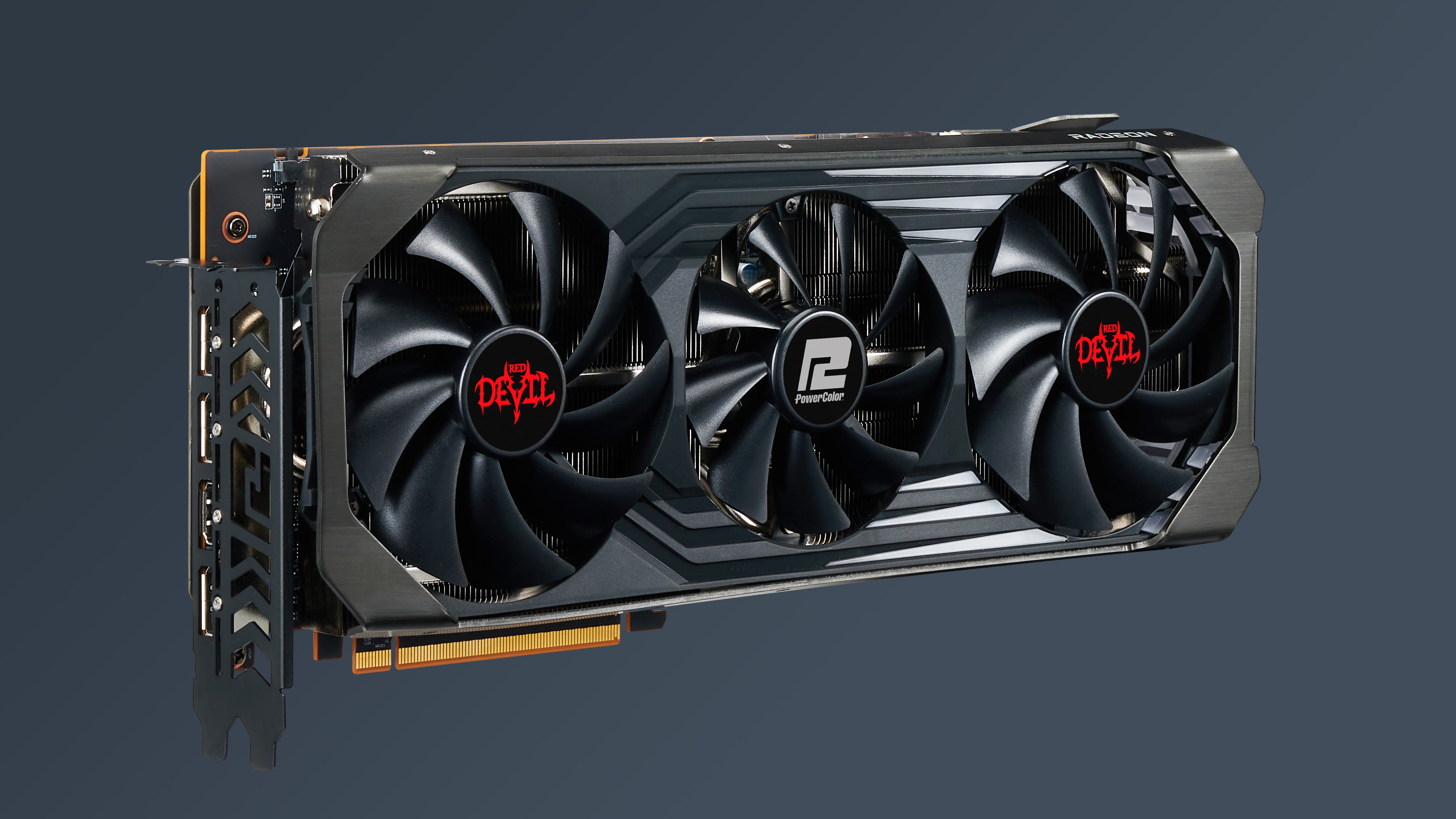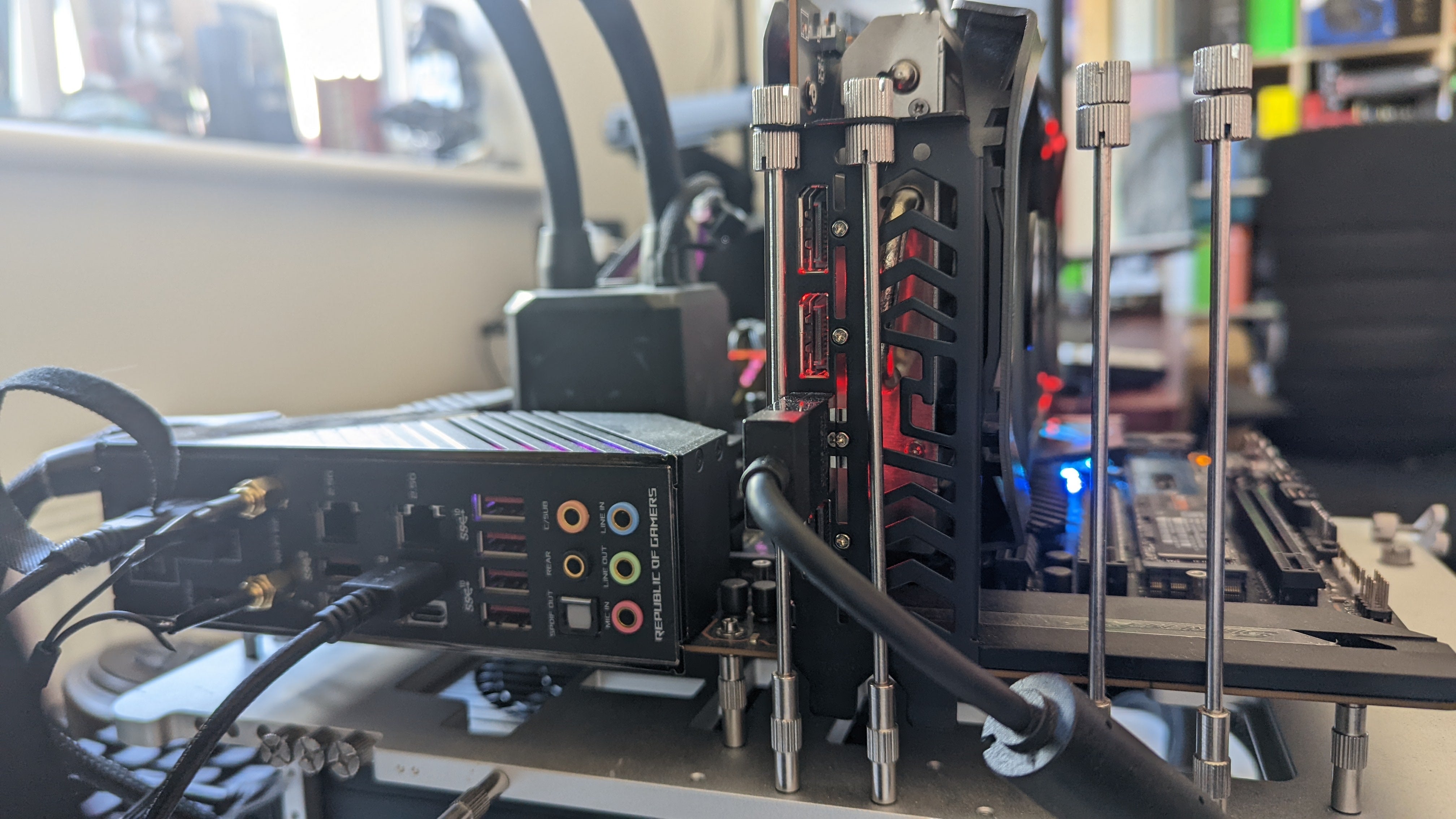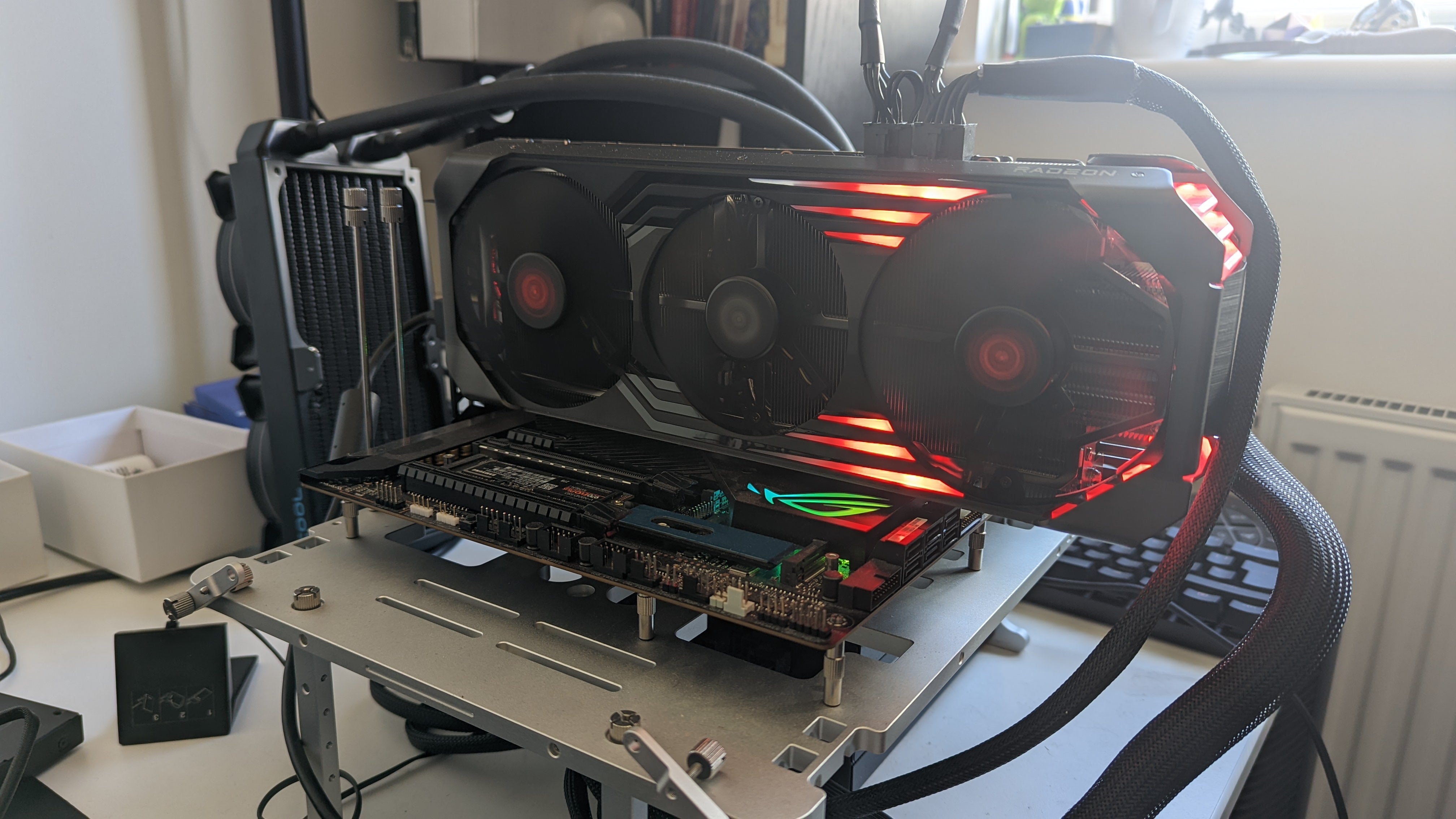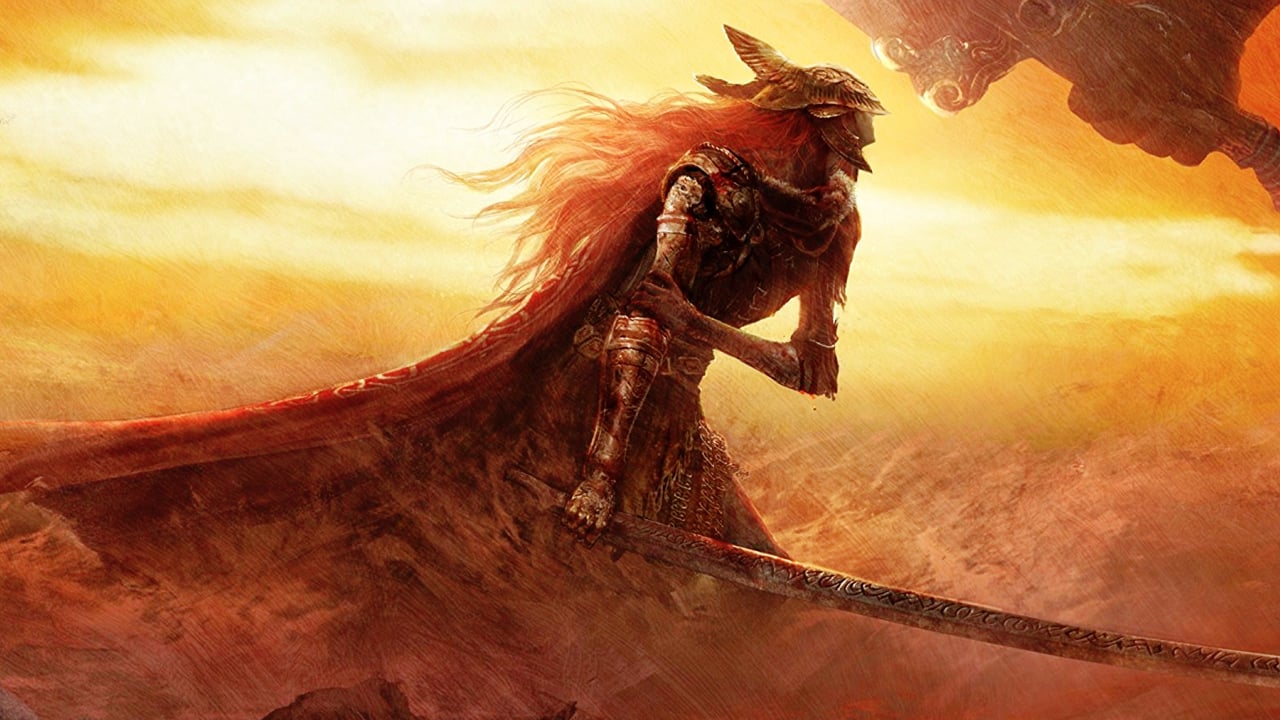The mid-generation Radeon 6000 update AMD announced today includes three new graphics cards: the $399 RX 6650 XT, the $549 RX 6750 XT, and the $1,099 RX 6950 XT. Each offers a small boost in memory speed (18GBps vs 6750 XT vs 16GBps for OG 6700 XT) and slightly higher power consumption (250W vs 230W). That should translate to a modest frame rate boost, but it’s largely a card that can replace the older RX 6700 XT rather than sit in its own unique powerband — albeit with an uptick in asking price. You can think of it as the Ryzen 3000 XT CPUs that came out months before the Ryzen 5000 — one last hurrah before the real next-gen arrives.
We’re looking for the middle child today, courtesy of PowerColor, who gave us the RX 6750 XT Red Devil. It’s an attractive card with a thick thermal solution, three fans, and the usual port arrangement: three DisplayPort 1.4 ports and one HDMI 2.1 port. As the name suggests, it lights up a hellish red and requires two eight-pin auxiliary power inputs.
On our unit, one of the card’s three fans appeared to be damaged in transit, as it hit the side of the shroud at low fan speeds. Thankfully, the card has a zero RPM mode when idle and doesn’t rattle once it hits around 50% fan speed, so this doesn’t affect performance and the card’s temperature is always low (and the clock speed is very low). high).
| AMD GPU Specifications | CU | boost clock | video memory | memory interface | TDP | price |
|---|---|---|---|---|---|---|
| RX 6950XT | 80 | 2250MHz | 16GB GDDR6 18Gbps | 256-bit + 128MB IC | 335W | $1099 |
| RX 6900XT | 80 | 2250MHz | 16GB GDDR6 16Gbps | 256-bit + 128MB IC | 300W | $999 |
| RX 6800XT | 72 | 2250MHz | 16GB GDDR6 16Gbps | 256-bit + 128MB IC | 300W | $649 |
| RX 6800 | 60 | 2105MHz | 16GB GDDR6 16Gbps | 256-bit + 128MB IC | 250W | $579 |
| RX 6750XT | 40 | 2581MHz | 12GB GDDR6 18Gbps | 192-bit + 96MB IC | 250W | $549 |
| RX 6700XT | 40 | 2581MHz | 12GB GDDR6 16Gbps | 192-bit + 96MB IC | 230W | $479 |
| RX 6650XT | 32 | 2416MHz | 8GB GDDR6 17.5Gbps | 128-bit + 32MB IC | 180W | $399 |
| RX 6600XT | 32 | 2416MHz | 8GB GDDR6 16Gbps | 128-bit + 32MB IC | 160W | $379 |
We used our standard test method here, which is based on a Core i9 10900K test system with all cores locked at 5GHz and kept cool by an Eisbaer Aurora 240mm AiO. Other components include 16GB G.Skill DDR4-3600 CL16 RAM, a Samsung 970 Evo Plus 2TB SSD from Box, an Asus Maximus Hero 13 Z590 motherboard, and a 1000W Corsair PSU.
Let’s jump right into gaming benchmarks. As usual, we’ll start with four games, which is usually the perfect time to differentiate a new GPU from an older generation alternative, thanks to a modern game engine using DirectX 12 or Vulkan to properly utilize our 10 cores 20 thread processor and push GPU utilization to the max.
We’ll then look at performance in more standard games, then three RT-enabled games to see if the RX 6750 XT can close the gap. As usual, you can hover over the graph to see the values, then click on them to toggle between raw frame rate and percentage difference.
doom forever
Doom Eternal: Vulkan, Ultra Nightmare, 8x TSSAA
Please enable JavaScript to use our comparison tool.
Since we used the Ultra Nightmare preset, our Doom Eternal benchmark was a challenge for cards with small VRAM allocations, but with 12GB of GDDR6 available here, the RX 6750 XT can hit high framerates without a problem, even if It’s 4K. We see the 6750 XT outperform the 6700 by 5% at this resolution, which would make the original card a better value if both were offered at RRP.
control
Controls: High, DX12, TAA
Please enable JavaScript to use our comparison tool.
Control is a game that suits Nvidia hardware rather than AMD, so it’s no surprise that the RX 6750 XT has a shortfall here, too. At 4K, the RX 6750 XT is 8% faster than its predecessor, but the nominally cheaper RTX 3060 Ti is even faster than that. The 6750 XT should be 22% faster at this resolution than the challenging RTX 3070. These results are for pure rasterization games, no RT – as we know from previous Radeon 6000 tests, RT usually skews the table further to Team Green…
Borderlands 3
Borderlands 3: Badass, DX12, TAA
Please enable JavaScript to use our comparison tool.
Borderlands 3 is another gaming example where we saw a relatively small performance gain from the RX 6750 XT over the RX 6700 XT, with the original card leading by only 3% at every resolution we tested.
death stranding
Death Stranding: Max, DX12, TAA
Please enable JavaScript to use our comparison tool.
Death Stranding is a game that performs better on AMD hardware, so it’s nice to see the RX 6750 XT continue this trend. It easily achieved an average of 74fps at 4K, 8% faster than the 6700 XT and a few percentage points behind the RTX 3070.
Far Cry 5
Far Cry 5: Ultra, DX11, TAA
Please enable JavaScript to use our comparison tool.
At lower resolutions, Far Cry 5’s CPU bottleneck is quite severe – but as the resolution increases, the differences between the different graphics cards start to become noticeable. The RX 6750 XT records its biggest advantage here, with a 10 percent lead over the 6700, while being three percentage points behind the RTX 3070. Yes, AMD!
hitman 2
Hitman 2: Ultra, DX12, TAA
Please enable JavaScript to use our comparison tool.
Another benchmark that affects both CPU and GPU is Hitman 2. At 1080p, it all counts, but at 4K we can see the RX 67500 XT have a staggering 15% advantage. Benchmarks may be particularly memory-intensive, or our RX 6700 XT results may be a little low. Either way, the RX 6750 XT was within touching distance of the RTX 3070, and our benchmarking tool recorded a 3.4 percent lead for the Nvidia card.
Assassin’s Creed Odyssey
AC Odyssey: Ultra High, DX11, TAA
Please enable JavaScript to use our comparison tool.
Abnormal results at 1080p, return to normal at 1440p and 4K, where the RX 6750 XT is 8% faster than the RX 6700 XT. However, the RTX 3070 fared much better in this regard, increasing its lead over the RX 6750 XT to 7%.
Metro Exodus
Metro Exodus: Ultra, DX12, TAA
Please enable JavaScript to use our comparison tool.
In Metro Exodus, the RX 6750 XT has a 9% lead over the RX 6700 XT, note this is a fully rasterized version with RT disabled – we’ll see RT performance later. The Nvidia graphics card seems to perform better here, with the RTX 3070 nearly 10% faster than the RX 6750 XT in this test.
Dirt Rally 2.0
Dirt Rally 2.0: DX12, Ultra, TAA+8x MSAA
Please enable JavaScript to use our comparison tool.
Dirt Rally 2.0’s built-in benchmarking capabilities are excellent – you can set the car, stage and settings you want in XML – but performance is very similar to what we’ve seen before, with the RX 6750 6% ahead of the XT over the 6700 XT. The new card offers reasonable 4K performance at 50fps, but Nvidia’s RTX 3060 Ti can match it for less.
Assassin’s Creed Unity
AC Unity: High, DX11
Please enable JavaScript to use our comparison tool.
The good old Assassin’s Creed Unity brought another surprising result, as the RX 6750 XT managed to get a 13% lead over the old card at 4K. Again, we might see scenarios where the extra memory bandwidth really comes in handy, or the run-to-run variance might push the goalpost a little further than we expected.
Control: Ray Tracing Performance
Controls: DX12, High, High RT, TAA
Please enable JavaScript to use our comparison tool.
The RX 6750 XT significantly outperformed the RX 6700 XT on Control RTX, with a 20% lead from 25fps to 30fps on average. This is unusual compared to our previous performance increase, but at such a low frame rate any increase in horsepower is a huge gain, so we’re not too surprised.However, AMD still sucks here, the RX 6750 XT comes closest RTX 3060 – not the RTX 3060 Ti or RTX 3070, which has been fighting for the rasterization part of this review.
Metro Exodus: Ray Tracing Performance
Metro Exodus: DX12, Ultra, Ultra RT, TAA
Please enable JavaScript to use our comparison tool.
There is a similar story in Metro Exodus with RT enabled, the new blood is 9% ahead of the old blood, but once RT is enabled, the RX 6750 XT again can’t compete with the RTX 3070 or even the RTX 3060 Ti – nor DLSS to improve frame rates, though FSR 2.0 may become that solution in any game that supports it.
Battlefield 5: Ray Tracing Performance
Battlefield 5: DX12, Ultra, Ultra RT, TAA
Please enable JavaScript to use our comparison tool.
Finally, we end with Battlefield 5, our unwavering entry into rocket blasts, semi-automatic rifle shots, and a variety of other WW2-era weapons. The RX 6750 XT is about 8% faster than its predecessor, but – stop me if you’ve heard this before – the RX 6750 XT comes closest to the modest RTX 3060 in terms of RT performance. The RTX 3070 is about 40% faster here – and that’s only with RT reflections, in a level with dirt and some shiny cars but barely any floor-to-ceiling shiny surfaces. This is AMD’s first-gen RT offering, and hopefully we’ll see major improvements to its next-gen hardware whenever it arrives.
RX 6750 XT: Digital Foundry Verdict
So, based on the benchmarks in the book, the question we have to answer is: Is the RX 6750 XT worth its asking price over the RX 6700 XT? By the numbers, no — you’re seeing less than a 10% performance boost in most games, but this card costs 15% more, at least for the nominal US MSRP ($549 vs. $479). However, as we’ve seen with the latest graphics card releases from Nvidia and AMD, the higher prices largely reflect the market — the price people are actually paying for graphics cards at a given level of performance — rather than vastly improved ones. signs of performance.
With that in mind, the RX 6750 XT is certainly no worse than the RX 6700 XT, so it’s entirely fair if it sells in bulk at the MSRP — we applaud AMD for taking the opportunity to shock without switching to a brand new GPU chip performance (or indeed, without the need for AIB to design a different cooling solution for its cards). But if you could choose between the RX 6700 XT and the RX 6750 XT — the latter does come with a 15% premium — then I’d go with the OG every time.
Table of Contents












